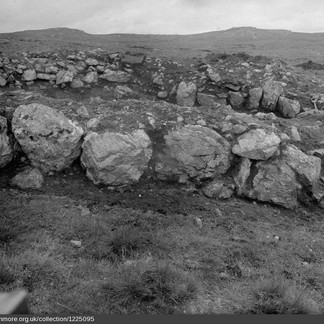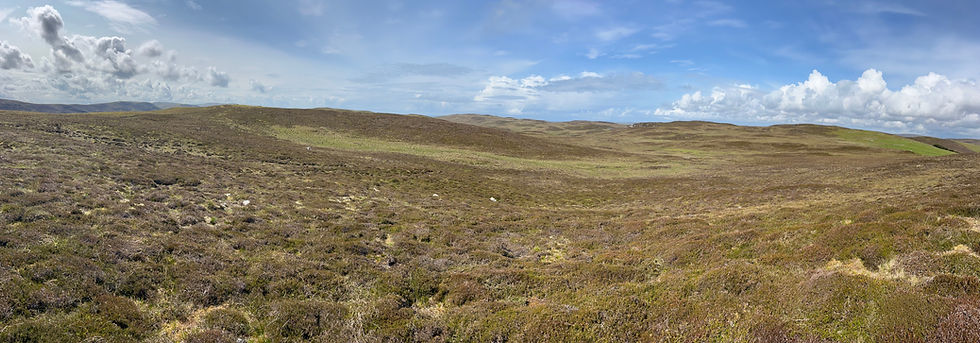In Depth - Temple Stories
- Stephen Jennings with contributions from Esther
- Apr 12, 2016
- 6 min read

If you recall earlier in the past year we visited Stanydale Temple in an In Depth article. We now want to revisit the site to look in more detail at the issue of interpretation and also to take a brief look at other similar sites. Keep in mind that within archaeology, as in many disciplines, there are often both shifts in interpretation and varying interpretations current at any one time. Here we’d like to choose the Neolithic/Early Bronze Age ‘temple’ sites of Shetland as an example to illustrate these changing perceptions and the potential for further research.
Dating from the late Neolithic or early Bronze Age, Stanydale is impressive measuring much larger than many of its contemporaries – an interior 11.7m X 6.6m with six alcoves each 1.25m deep and all surrounded by 2.6m walls. Likely built with a turf roof supported by large spruce posts lashed together in two post holes, each alcove appears to have had its own small hearth rather than a central hearth as is more commonly found. The lack of evidence of domestic activity in the interior and the alignment between the entranceway and a pair of standing stones has led to the site being categorised as possibly ritual in nature and if not a true ‘temple’ at least an important gathering place with ceremony in mind. Our previous article summarised research by Clarke and Renwick (2013) which suggests that in the surrounding landscape there is also evidence of a processional causeway marked by stones leading to a loch side mound 900m away and aligned carefully to the rising and setting sun of the equinox.
Yet, despite some of the compelling evidence and what has quickly become accepted lore, many challenging questions remain.
Foremost among these and the most straightforward to answer is the notion Stanydale itself is unique. If you recall we also explored earlier in the year Neolithic and Bronze Age Burwick where another 'temple' can be found that is nearly identical – approximately 10.5m x 7m with the same six orthostatic layout configuration, two large post holes, an entrance on the same E-W orientation and evidence of extremely thick walls in its original phase yet sans a processional causeway or ceremonial evidence. This site was recognised and remarked upon by the excavator of Stanydale, C.S.T. Calder, though nothing more than a cursory survey is ever known to have taken place. The surrounding landscape has been heavily impacted by peat cutting and storage which is perhaps no more evident than the 8-10 large and derelict peat crues 150m north and a peat road less than 100m west. There are also long prehistoric walls of unknown date and origin criss-crossing the land and burnt mounds roughly 550m away. The area is otherwise and virtually sterile, the closest known habitation sites a late Neolithic/early Bronze Age homestead (also noted by Calder, see: https://canmore.org.uk/site/711/jamie-cheynes-loch) more than 1100 metres north and Bronze Age roundhouses 1100 metres south. There is some evidence of prehistoric activity a few hundred metres east on the hill opposite the site and also a few hundred metres west on the backside slopes which do warrant more intense scrutiny yet none of these at this point bear resemblance to much more than agricultural activity and the contemporaneity is impossible to discern.
A further site can be found in Whalsay just outside of Sandwick in an area known as Little Ness. It is a complex of at least three large Neolithic buildings one of which, though greatly degraded, very closely resembles the 'temple' sites. A mixed use and mixed period landscape, the buildings have been reduced to foundational level and the enclosure walls come from all periods making an interpretation of the site extremely difficult. Nonetheless, it remains another example on the landscape which challenges the idea Stanydale is unique and, further, begs the question how many more there may yet be throughout Shetland.
Turning back to Stanydale and the excavation by Calder in 1949, the earliest period evidence from the site is based on sherds of beaker pottery which seem to confirm a Neolithic date, early Bronze Age at the latest. However, it is believed the site remained in use through the Iron Age based on artefacts found well above the original floor level and also into the modern period where it was used as a sheepfold with loose elements from the eastern side of the site used to shore up the western. Aside from this more modern alteration and attendant stone robbing it is acknowledged the preponderance of the site had at least two major building phases. This has been picked up on by Mahler (Mahler: 17) where he laments the mixing of two distinct construction eras makes deconstruction problematic. It's an important point because we are not starting with an untouched monument from the Neolithic but instead are charged with parsing through major phases of modification or outright reconstruction and are thus starting from an uncertain base point.
When investigating the ‘temple’ label Calder attached to these sites it is also wise to question at what point in the excavation and reconstruction the idea of a 'temple' occurred to him and so we should take a quick look at how he put his argument together.
Noticing a resemblance to the heel-shaped burial cairns found throughout Shetland, though on a much larger scale, and Stanydale's dissimilarity to known domestic structures he believed the two were necessarily connected. It was not a novel concept as this was the case with similar structures on Malta, ones with which Calder was directly familiar, where the sepulchral connection was quite well established (Calder: 203). Yet here perhaps the greater leap was not in Calder connecting Stanydale to heel-shaped burial cairns but in believing the structure was itself directly influenced by those on Malta, an idea with scant evidence. For this reason it is important to question when the temple idea occurred not simply because the leap in logic, connecting Shetland with Malta, is quite startling but because he may have approached his excavation with the idea in mind and thus the reconstruction phase could have been guided by preconceived notions of a temple that may have been more hopeful than the evidence suggested.
All that being said, Calder did note the alignment between the passage and the standing stones and Clarke and Renwick and Mahler’s papers have both noted, separately, other remains of an aligned route to the site. The doorway faces east and a stone marked route leads to a ditch and bank surrounded mound on the shores of the Loch of Gruting and aligned nearly perfectly with the rising sun during the equinox. If you were to turn and face west back toward the temple where it falls into a notch between the hills this would of course mark a point where the sun appears to set directly behind. This was almost certainly done with deliberation as random chance is unlikely and so there is a planned landscape in existence with the ‘temple’ situated in front of what is possibly an associated village and a route leading out over the hill to the mound at the edge of the loch.
A last and related point that we'd like to lightly touch on is our own preconceived notions of ritual and ceremony as it relates to prehistory. Without question we have very little knowledge of any rites or ceremonies other than the physical objects left behind such as, in this example, a landscape. In that sense the image of stone-faced processions guided by stern, hooded priests while the adherents cower is in most ways a fallacy of modern popular culture and not an accurate interpretation. Anything can look peculiar from a distance. Take for instance our Christmas trees – does this type of worship not appear just a bit bizarre? Yet it is done for tradition, community and for entertainment and are we so sure that much of what we interpret as ritual and ceremony was not in some way the same? In the case of Stanydale are we so sure it wasn't an economic or status procession as much as or instead of religious? For that matter, could orientation of such things as the entrance or the processional causeway be as much about the traditional or the practical as the ritual? These are all alternative ideas worthy of some consideration.
As remarkable a site as Stanydale Temple is we have established it is not unique on the landscape though it may yet continue to be unique to Shetland. And while the original interpretation of a Maltese influence has fallen from favour the idea of a 'temple' still appears to resonate in the public imagination no matter how misguided it may be. There are alternative interpretations such as a community hall or high status dwelling and we've highlighted some of those aspects here but in reality it may be that little short of continued excavation - and we do have the sites - will push the issue forward.
References
Clarke, S and Renwick, E (2013) "A Processional but not Processual Approach to Stanydale Neolithic Temple" in Foulds, F (ed) Experimental Archaeology & Theory: recent approaches to testing archaeological hypotheses. Oxbow
Calder, C. S. T. (1950). Report on the excavation of a Neolithic temple at Stanydale in the Parish of Sandsting, Shetland, Proceedings of the Society of Antiquaries of Scotland, vol.84: 185-205 Figs, 1,6
Also available online at https://archaeologydataservice.ac.uk/archiveDS/archiveDownload?t=arch-352-1/dissemination/pdf/vol_084/84_185_205.pdf
Mahler, D (2011). Shetland – the Border of Farming 4000-3000 BCSome Features of the Neolithic of Shetland, in D. Mahler & C. Andersen (eds) Farming on the edge: Cultural landscapes of the North Rosendahls - Schultz Grafisk
Also available online at http://nordligeverdener.natmus.dk/fileadmin/site_
Calder Excavation, Photographs courtesy of RCAHMS













Comments